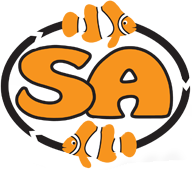Peppermint Shrimp
- Species Information
- Scientific Name:Lysmata wurdemanni
- Described:Red stripes that run horizontally down the body.
- Origin:Captive Bred
- Temperament:Peaceful
- Maximum Size:3"
- Ideal Tank Size:Any
- Notes:Eats Aiptasia

ysmata wurdemanni
The peppermint shrimp, Lysmata wurdemanni, is a great addition to saltwater aquariums experiencing problems with Aiptasia anemones.
These shrimp grow to around 3 inches in length and consume large amounts of the troublesome pest anemones. Due to their nocturnal nature, they will likely hide in the rockwork during the day and forage during the night on anemones and leftover food. As they become more accustomed to aquarium life, they will likely be more active during the day. The peppermint shrimp gets its name due to the red stripes that run horizontally down the body. It is often confused by novice aquarists with the camelback shrimp, (Rhynchocinetes durbanensis) which will not consume Aiptasia, has a more erratic pattern of white and red, and is found in the Pacific.
The peppermint shrimp is found primarily in the Atlantic, Caribbean, and Gulf of Mexico where Aiptasia species are found. For large infestations of Aiptasia where polyps are greater than a half inch in diameter and cover a majority of the aquarium, we recommend adding our captive bred Berghia Nudibranch species to help begin eradication of the Aiptasia.
We then encourage aquarists to add a few peppermint shrimp once the Aiptasia has been decimated to ensure new infestations do not reoccur. This method is used because berghia require Aiptasia to live; so once the pest is removed, the berghia will starve, whereas the peppermint will scavenge for other food that is remaining in the tank.
Thank you for stopping by and checking out our website! Sustainable Aquatics is an ornamental marine and freshwater fish hatchery, located in Jefferson City, Tennessee. Sustainable Aquatics’ history and mission are to serve all its constituents; customers, partners, vendors, employees, suppliers, the environment, and future generations by advancing processes and practices that benefit all and make things a bit better in quality, service, delivery, and value.
We would love to have you follow us on Facebook!






